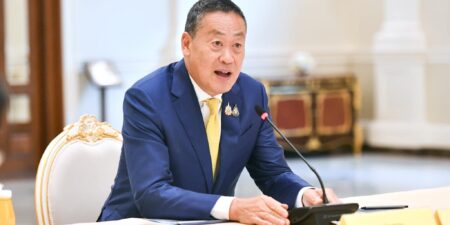
Technology Forecast

WHAT YOU NEED TO KNOW
- The ASEAN Guide on AI Governance and Ethics was released February 2. Entirely voluntary, it suggests a light touch and flexible approach on managing artificial intelligence (AI) risks, reflecting the region’s fragmented policies and capabilities.
- Singapore’s recently revised National AI Strategy signals a shift from viewing AI as an opportunity to something essential. Singapore aims to establish itself as a trendsetter in global AI readiness efforts.
- China has made investments in AI research and development and is asserting its influence in shaping global AI governance. Beijing has released guidelines and policies to promote AI innovation while emphasizing surveillance and control measures through policies such as the New Generation Artificial Intelligence Development Plan and the Cybersecurity Law, which includes provisions related to AI security and data protection
ON THE HORIZON
- Following the U.K.-led Safety Summit in Bletchley in November 2023, a mini virtual summit was held in Korea in May before a Paris summit toward the end of 2024 or early 2025.
- With the EU AI Act set to take effect, governments in the region will begin to study how to adapt the landmark risk-based legislation for domestic purposes.
- The Australian government’s regulation of AI will focus on the technology’s use in high-risk settings by establishing mandatory guardrails, with a focus on testing, transparency and accountability. Australia will also work with industry to develop a voluntary AI safety standard and develop options for the voluntary labeling and watermarking of AI-generated materials.
- Competing interests such as the need to foster growth and innovation while upholding local and sovereign interests in data and interoperability and the protectionist sentiments of some markets will result in regulatory divergence.
Sector Overview and Forecast
Macrotrend Monitor
Generative Artificial Intelligence Is Transforming Asia
It is difficult to capture the commercial and political impact of generative artificial intelligence (GAI) on both commerce and politics in Asia without hyperbolizing. Investment in GAI is driving global industry growth at every point in the technology value chain at an unprecedented rate, and the Indo-Pacific is ground zero for this growth. The United States is leading the development of large-language models (LLMs). Taiwan and Korea — and increasingly Japan and the United States — are the principal manufacturers of AI-enabled semiconductor chips. Japan and Singapore are evolving into AI hubs due to their strong cloud infrastructure. India, Malaysia and Vietnam are capturing increasing shares of technology manufacturing as supply chains shift from China.
From South Asia to Oceania, the Indo-Pacific will see the greatest impacts from AI deployment due to governments’ strong embrace of private sector-led innovation. In addition to manufacturing, GAI is driving economic productivity growth well outside of what is traditionally referred to as the technology sector. OpenAI’s online data-driven LLM-based chat application ChatGPT may be garnering the most attention in the public discourse, but industry- and profession-specific AI applications, especially low- and no-code solutions for traditionally technical subjects, are reducing barriers to entry and increasing the productivity of small and medium-sized enterprises.
Internet-of-Things systems are transforming sensor data to bring AI into advanced manufacturing plants, transportation management systems and national energy grids. Health-based data is improving medical devices and will transform how doctors identify cancer treatments and develop vaccines for the next pandemic. Weather and climate data is helping governments anticipate and respond to natural disasters and make local agriculture more resilient.
GAI is poised to advance tectonically in the coming months with the introduction of large-action models, driven by sensor- and health-based data along with GAI agents that can interface with other systems and AI agents when prompted. From making lunch plans with friends to level-five autonomous driving vehicles, the upcoming leap in GAI will transform all aspects of commerce and society.
Working To Ensure AI Is Developed and Deployed Safely
As witnessed in Ukraine, AI has already demonstrated an ability to add speed, scale and synergy to militaries in armed conflicts. In conflicts short of war, GAI will make disinformation campaigns more sophisticated and difficult to defend against. The democratization of technology includes dangerous technology, and LLMs threaten to give cyber- and bio-warfare capabilities beyond nation states to terrorists and other subnational combatants. Governments across the Indo-Pacific are deeply concerned about these prospects and are working to not only secure the domestic industrial capabilities to build AI systems but also to enhance the safety and security of AI systems by establishing shared principles and standards and protecting frontier models from theft.
AI legislation and regulations in most Indo-Pacific countries are still in nascent stages, with various voluntary guidelines and ethical principles released more often than mandatory legislation is passed. The current regulatory discourse is predominantly focused on the risks and harms of AI. The European Union’s AI Act, en route to coming into force, establishes a risk-based approach to regulating AI, which may lead to a wave of countries following its example as a key global benchmark for regulating AI.
Global cooperation is also focused on AI safety. AI was a topic of discussion at the California summit between Chinese President Xi Jinping and U.S. President Joe Biden last November, and a high-level bilateral dialogue kicked off in May. A high-profile AI Safety Summit first held in the United Kingdom in November 2023 led to the Bletchley Declaration, signed by 28 countries including major Indo-Pacific economies like China, India, Japan, Korea and Indonesia. The declaration aims to foster cooperation in global AI safety efforts. AI safety institutes were launched in the United Kingdom and the United States last year, and an AI Safety Institute in Japan was announced in February. The AI Safety Summit took place in Asia in May, hosted by Korea, and then participants will convene in Paris as the summit marks its first anniversary next autumn. At the same time, ASEAN has worked to develop its own Guide on AI Governance and Ethics, which outlines seven guiding principles for the design, development and deployment of ethical AI systems and aims to conclude negotiations on a Responsible AI Roadmap by the end of this summer.
While the ASEAN and Paris discussions will likely remain focused on identifying risks and securing the safe development of AI, this is only the beginning for overall AI regulation. Policy discussions on the broader AI ecosystem go beyond the potential risky outcomes of AI technology and encompass many, if not all, components of the digital economy. The nine core elements of ASEAN’s Digital Economy Framework Agreement under negotiation — digital trade, cross-border e-commerce, payments and e- invoicing, digital ID and authentication, cross-border data flows and data protection, online safety and cybersecurity, cooperation on emerging topics, talent mobility and cooperation and competition policy— are all foundational to the effective embrace of AI.
Market competition is another area that companies need to watch closely. Investors should expect regulators to increase scrutiny as gatekeepers race ahead in the AI space through aggressive investments and acquisitions and consider if commercial activity could crowd out smaller domestic players that lack global resources. Companies should watch the data sovereignty discourse as it evolves to explicitly address GAI, especially as the United States introduces its own concept of “digital solidarity” in the region to serve as a counterpoint to data localization trends. At the same time, corporate stakeholders should engender an ecosystem predicated on shared values, safety and interoperability.
Embracing Industrial Policy To Diversify the Semiconductor Supply Chain
The geopolitical stakes of the AI revolution are driving a renewed embrace of industrial policy around the world and particularly in the Indo-Pacific, which serves as the home of the incumbent global semiconductor supply chain. U.S. National Security Adviser Jake Sullivan’s “small yard, high fence” doctrine shaping the Biden administration’s competition policy with China is focused squarely on strategic and emerging technologies that will power the AI revolution, especially the resources necessary to manufacture “advanced” chips of 7 nm (nanometer) process node or smaller.
Superficially, the recipe for success in AI is straightforwardly an equation of data volume and computing power. These categories belie the myriad challenges governments and companies alike are facing to secure the necessary resources, including energy and talent, to shift AI supply chains in their interests.
On the computing side, semiconductor design companies are investing billions of dollars in research and development to push the bounds of graphic process units (GPUs), central processing units (CPUs) and memory to increase the computing power and efficiency of new server racks. Semiconductor fabrication and foundry companies are breaking ground on new plants to fuel the demand for these chips.
According to the Semiconductor Industry Association, private sector investment in chip production is projected to grow to about $2.3 trillion between 2024 and 2032.
Indo-Pacific governments are keen to encourage domestic growth of their semiconductor industries, led by the United States. The bipartisan 2022 CHIPS and Science Act gave the Commerce Department $32 billion in subsidies to allocate to domestic semiconductor manufacturing. In the last half year, Secretary Gina Raimondo has announced more than $29 billion in allocations.
Japan has said it will make $26.4 billion in subsidies available to domestic production efforts. In April, the Ministry of Economy, Trade and Industry announced it awarded $3.9 billion in subsidies to moonshot fab model company Rapidus, which was established in 2022 and aims to produce 2 nm process chips by 2027. In February, the ministry announced $4.9 billion in subsidies to Taiwan Semiconductor Manufacturing Company Ltd. to expand its new local facility in Kumamoto, and a new plant is expected to begin production in 2027. Not to be outdone, Korea’s Yoon government unveiled in January a plan in which Samsung and SK Hynix will invest $471 billion to build 13 new advanced fabs in a “chips hub” south of Seoul. Korea in March 2023 passed the K-Chips Act, which provides an 8-15 percent tax credit for capital expenditure in domestic production.
The United States, Japan, Korea and Taiwan make up a U.S.-led proposed “Chips 4 Alliance” aimed at aligning these industrial policies, diversifying supply chains and minimizing global industrial reliance on China for semiconductors. This involves not just fabs but coordination across design, foundries, equipment manufacturers and raw materials, including critical minerals and chemicals.
Advanced semiconductor fabs demand a strong manufacturing ecosystem and capital allocations that few economies can afford. Singapore is relying on its rich ecosystem of existing fabs, its competitive workforce and its ease of doing business to maintain its strength in the sector despite competing with the industrial policies of much bigger economies. Malaysia’s New Industrial Master Plan 2030 aims to develop the domestic semiconductor industry beyond assembly and testing into more value-added production, such as wafer fabrication and integrated circuit design.
Leveraging the global supply chain reorientation, India is also working to position itself as a global semiconductor manufacturing hub through the “Make in India” initiative and production-linked incentive policies amounting to billions of dollars in subsidies for new semiconductor capital expenditure in the country. However, the country faces significant challenges given its nascent fab ecosystem and workforce historically oriented toward the design and software side of the industry. The U.S.-India bilateral framework Initiative on Critical and Emerging Technology is providing momentum to the government’s efforts and adding a Quadrilateral Security Dialogue element to India’s commercial ambitions.
Building Digital Infrastructure for AI
As important as computing, access to data is a critical variable in the function for AI success. Last year, the Asia-Pacific Economic Cooperation (APEC) forum’s telecommunications working group endorsed recommendations for cloud transformation, focusing on skills development; infrastructure investment across fiber, satellite and 5G; cross-border data flows; the adoption of global technical standards; and renewable energy, all of which are essential to foster a stronger ecosystem for digital services, including AI. Investors in Asia should also look forward to the next ASEAN Master Plan on Connectivity; the current 10-year master plan goes through 2025.
Improving connectivity, from spectrum allocation and fiber rollouts to the adoption of global technical standards, has been challenging imperatives in Asia. Nevertheless, data center growth is booming to bring Asia online. Asia broke through the 10-gigawatt threshold of installed capacity this year and has as much capacity and more in development or planning stages.
Supplying Renewable Energy To Fuel Compute
Asia’s demand for energy is a critical limiting reagent for industry growth and commercial sustainability. Rising interest rates, the continued war in Ukraine and interruptions in Red Sea shipping lanes, in combination with endogenous shocks within the energy industry — which our colleagues in BGA’s Energy, Climate and Resources Team have elaborated on in a separate report — are placing macro energy security challenges on the technology industry that suppress the growth of electricity supplies and especially renewable energy supplies to meet rising demand for compute.
Even as AI becomes an increasingly important strategic sector for governments to support, Asian governments are considering unplugging the sector until more sustainable energy solutions can be identified. Despite leading the world in computing per capita, Singapore ended a four-year moratorium on new data centers in July 2023, allocating 80 megawatts of facilities to four companies that met the country’s new 1.3 power usage effectiveness (PUE) cap — by comparison, Germany will implement a PUE cap of 1.2 for new data centers by 2026. The same month, Taiwan began its own moratorium on new data centers over 70 megawatts.
Clean energy supply is not the sole energy security challenge the region faces. Japan confronts steep power availability challenges in central business districts due to grid capacity. Korea will implement the Dispersed Energy Act in June to convert its centralized power tariff system, allowing power suppliers to set different electricity prices by region and encouraging data center geographic diversification.
Investing in Skills for an AI Workforce
Most employers and government officials in Asia believe their economies face a skills gap for the digital future, and public-private cooperation to bridge the divide is essential for both parties. Governments should embrace AI as a central component to boost skills, provide AI-enabled devices to students to learn in hands-on environments and develop AI training and AI transition assistance programs. APEC’s telecommunications working group last year endorsed “workforce training that emphasizes digital skills, entrepreneurship, cybersecurity, advanced education and professional certifications” and partnerships with industry in its recommendations for cloud transformation.
Asian governments are remarkably optimistic about the potential for AI to improve the livelihoods of the people in their economies, but the transition will be challenging for workers in Asia. AI will automate manufacturing jobs and digitally enabled services, such as business process outsourcing, that make Asia ripe for AI innovation in the first place. Without effective skill and reskilling programs, the disruptive force of GAI will outpace the benefits for some communities.
In Singapore, as part of the updated National Artificial Intelligence Strategy, the government aims to grow the number of AI practitioners to 15,000 by scaling up its AI Apprenticeship Program and develop the skills of the general workforce to promote AI adoption. On the other hand, countries facing an aging workforce, like Japan, may find that AI’s potential to increase productivity eases their manpower shortages. Investors must be politically cognizant of the varying challenges different societies face and forward leaning to engage governments in partnerships and mitigate negative externalities for both ethical reasons and their own long-term interests. Some companies are already pairing AI investments in Indo-Pacific markets with commitments to introduce related programs to support skills development. This is a positive move, but continued alignment with government goals and needs is critical to ensure that the introduction of AI benefits economies and workers in the long run.
We will continue to keep you updated on technology developments as they occur. If you have comments or questions, please contact BGA Enterprise Technology Senior Director William Heidlage at wheidlage@bowergroupasia.com or BGA Platform Technology Senior Director Apoorva Kolluru at akolluru@bowergroupasia.com.
Best regards,
BGA Technology Teams

William Heidlage
Senior Director

Subscribe to Asia Street
Insights & News


India’s Union Budget 2024 Fuels Jobs, Investment, Infrastructure and Resilience
The BGA India Team, led by Managing Director Ratan Shrivastava, wrote an update to clients …
 Ratan Shrivastava
Ratan Shrivastava

Australia Strengthens Indo-Pacific Security Cooperation in Series of Engagements
The BGA Australia Team, led by Managing Director Michael “Mick” McNeill, wrote an update to …
 Michael McNeill
Michael McNeill

Thailand’s Post-Election Reset
BGA Senior Adviser Dr. Thitinan Pongsudhirak wrote an update to clients on Thailand’s new political …
 Dr. Thitinan Pongsudhirak
Dr. Thitinan Pongsudhirak
At BowerGroupAsia, we are committed to
delivering result-oriented solutions for our clients
We have proven track record of helping the world’s top companies seize opportunities and manage challenges across the dynamic Indo-Pacific region.



















